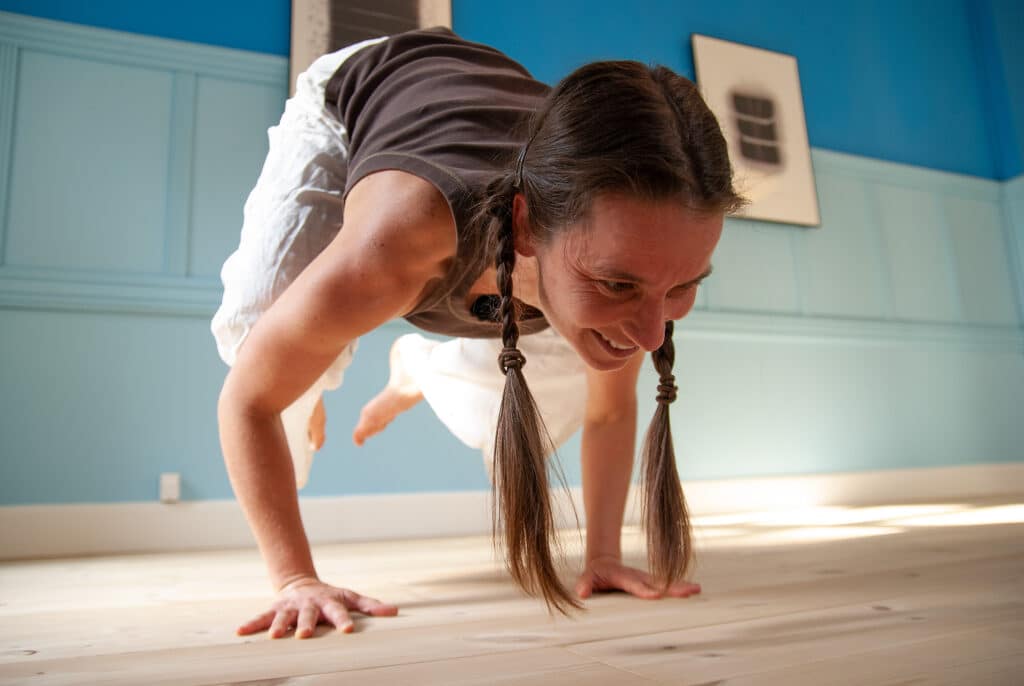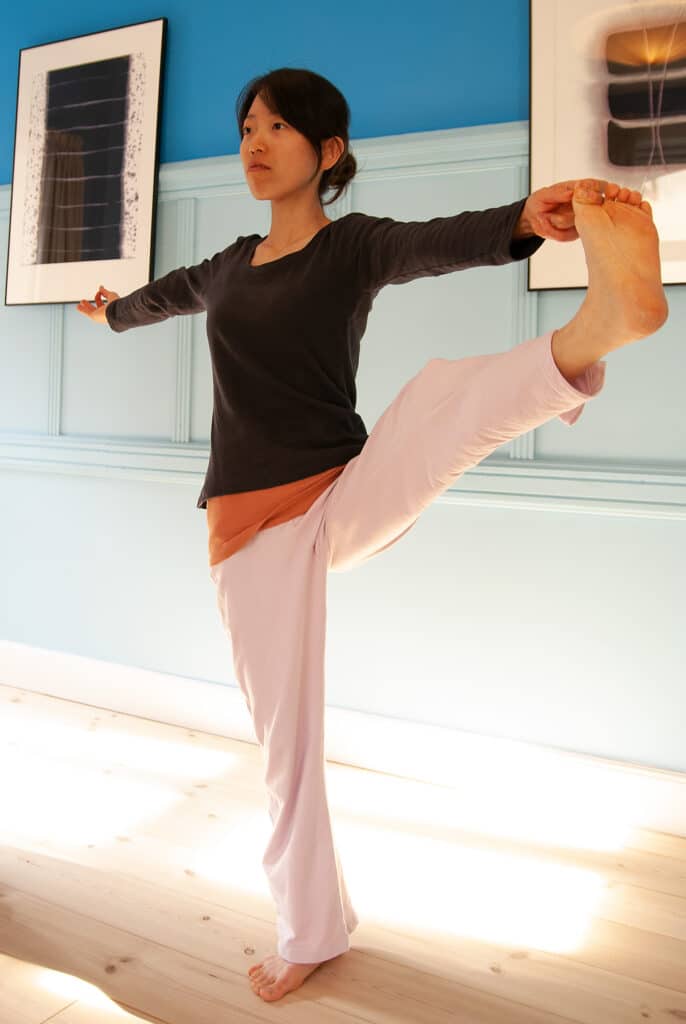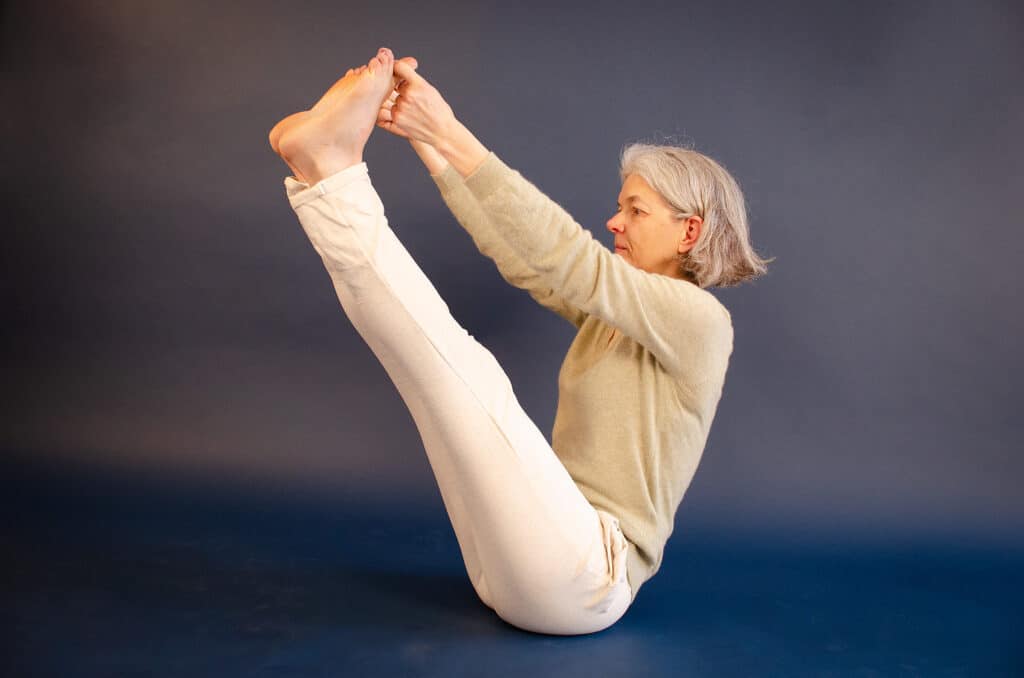Balancing poses in yoga are beneficial in many ways. For example, they strengthen your core muscles, tone connective tissue and train your nervous system. Here is an overview of everything you get out of practising balance poses.
Why yoga poses are suitable for balance training
Balance is a fundamental skill; without it, we couldn’t even stand up. A poor balance makes our movements clumsy and we waste our energy. On the other hand, thanks to an excellent balance, we can move swiftly and effortlessly.
Balancing poses in yoga are wonderful for training balance. They are easily accessible since you only use your body, and you can easily choose your difficulty level. There are super easy balancing poses that anyone can do. At the same time, thanks to challenging asymmetrical positions, you can perfect your skills if you already have nailed the basics.
Training balance as physiotherapy or in sports is good. However, when you practice yoga, you encourage awareness and concentration to a greater extent. Because of the relaxed state of mind you are in, the exercises act on a deeper level. Balancing poses are a crucial component in physical yoga. When done in the right way, they are excellent stepping stones towards breathing exercises and meditation.
These are the eight most essential benefits you get out of yogic balance training.
1. Enhance focus and concentration
Forging a concentrated mind is crucial in yoga. Keeping balance is complex for the body and the nervous system. Therefore challenging your balance is an efficient method.
When you practice concentration sitting in a meditation pose, mind-wandering can quickly start. However, when you are in a demanding balancing pose, you get immediate feedback on your concentration level. The posture forces you to stay focused, or you will fall.
Balancing poses are especially suitable for beginners to meditation and concentration. Doing a series of balancing poses before meditation will help you build up focus and go deeper than you would without preparation.
If you want to know more about how yoga and meditation trains your concentration, this article that treats the subject in-depth will surely interest you.

2. Improve spatial body awareness
Spatial body awareness (also known as proprioception) is the sense of how your limbs are oriented in space. Practising yogic balancing poses is an excellent way of developing a good understanding of the exact position of your body parts and helping them move in space. As you develop this skill, your movements will become smoother and more controlled.
3. Improve neuromuscular coordination
Balancing poses requires all the muscles in your body to cooperate. Your brain and your nervous system need training to do this efficiently. Having developed neuromuscular coordination, you will be able to stay in difficult poses gallantly and to move in and out of them smoothly.
Good neuromuscular coordination also has benefits outside of the yoga room. When your whole body works together, you become both more powerful and better at coordinating movements. By using force more efficiently, your endurance improves too.
4. Build joint stability
Balancing poses help to protect your multiaxial joints by making them more stable. Ankles, knees, hips and shoulders all benefit from increased stability. They become stronger and more resistant to injuries such as ankle sprains and torn ligaments.

5. Decrease reaction time
By doing poses that train your balance, your body learns to quickly react if you are about to fall or if there are external influences. Thanks to more challenging poses, you will continue to decrease reaction time and work towards perfect compensation. Practising on an unstable surface, such as a thick yoga mat, is particularly useful to improve reaction time.
6. Improve agility
Agility is the capacity to move quickly and with ease. Agility requires coordination, fast reaction, and strength. Since these qualities require balance, yoga poses that challenge your balance will also improve agility.
7. Reverse age-related loss of balance
As we grow older, our sense of balance declines. Unfortunately, injuries from falls are common in the elderly. If you are in your seventies or older, a severe fracture can be disastrous. Therefore, good balance is crucial as we age. Did you know that how good you are at standing on one leg can be used as a predictor of how long you have left to live?
The good news is that by training your balance, you can stop it from declining and even radically improve it. For healthy ageing, it’s a good idea to think ahead and start paying attention to your balance already in your forties.

8. Prevent lower back pain
According to WebMD, balance training is one of the best ways to strengthen your core and prevent lower back pain. Several studies show that people with chronic lower back pain had poorer balance than their healthy peers, for example, this one.
Yoga poses are well known for increasing lower back health since they help increase strength, flexibility and blood circulation. The combination of muscular contraction and relaxation you get from balancing poses is particularly beneficial. This is valuable to yogis since having a fit lower back is crucial for long meditations.




